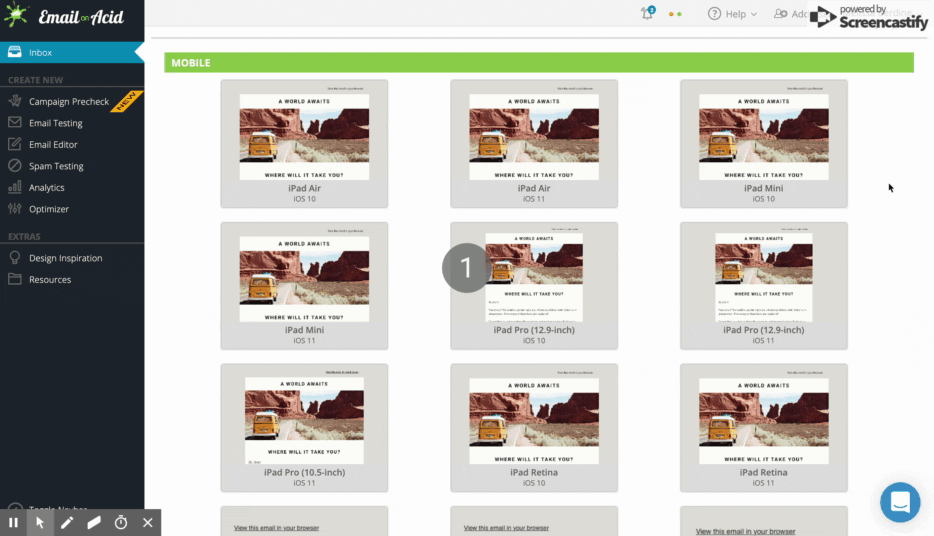Email Marketing
The Secret to Deliverability: Tips from Privacy Expert Chris Arrendale

Email Marketing

In our recent email marketing deliverability webinar with Trendline Interactive’s Chief Privacy Officer, Chris Arrendale, he shed some light on what it means to have good deliverability.
One of the biggest hurdles email marketers face isn’t just motivating an open or making sure every CTA works perfectly. Rather, it’s how to make sure emails land in the inbox in the first place, not the spam folder.
We should pause here to clarify that deliverability is different from delivery. Delivery means the client receives your email, even if it lands in the spam folder. An email bounce would mean the email wasn’t delivered. Deliverability, on the other hand, is whether your email makes it to the inbox.
Unfortunately for email marketers, factors such as email client updates and email address changes make 100% deliverability impossible. That said, 95% deliverability is a good benchmark to strive for. So long as you’re emailing an engaged audience on a healthy list, your deliverability rate should be about equal to your delivery rate.
One thing that you want to look at is your list health. List health is key for good deliverability because it helps ensure bounce, complaint, and unsubscribe rates are kept low. When determining list health, marketers should strive for a bounce rate under 4% and an unsubscribe rate under 1%.
Delivery is what happens prior to deliverability. If delivery = # of emails sent – # of emails bounced, then delivery is when the recipient’s mail server accepts the email. Now, once the email is in the subscriber’s mail server, that mail server determines which folder to put it in: spam, inbox or quarantine.
This decision ultimately comes down to multiple filters and rules that the recipient’s personal mailbox has in place to determine where emails go.
Deliverability is not just an email’s placement in the inbox, spam or quarantine, but it’s also the reason(s) why an email bounces.
There is no email tool in the world that will tell you exactly the number of emails that go to the inbox vs. junk folder vs. quarantine. But, there are tools that will troubleshoot and help determine if there’s a problem with content filters, reputation, engagement, or blocklists.
Oftentimes during an IP warming phase, you might see higher rates for these since emails are finally making it to the inbox. Subscribers might not remember signing up, so don’t panic, it’s just running its course.
However, if you’re seeing high rates in these areas outside of an IP warming phase, there could be larger issues at play. High unsubscribe rates, above 1%, are often an indicator that the content doesn’t look right to the subscriber. Maybe they don’t remember signing up for the list or they’re not receiving the emails they were expecting.
The same logic holds true for complaints. If a subscriber can’t find an unsubscribe link, they’ll hit the complaint button. This can really hurt the sender’s deliverability and reputation. Getting too many complaints can present major issues. However, Chris says that having a small amount of complaints is actually good, because it’s simply an indicator of inbox placement. If no one’s complaining, then maybe no one’s getting your emails.
Tip: Check in on your complaint and unsubscribe rates regularly. If you’re not seeing a single one over the course of several months, that could mean your emails are going straight to spam.
Your subscriber list can have the most helpful (or hurtful) impact on your deliverability rate.
The double opt-in, or as Chris calls it, the Chief Revenue Killer, is great for deliverability. (He only calls is the Chief Revenue Killer because not everyone is going to confirm… but it’s still worth it.) Having a list with double opt-ins helps keep complaints and unsubscribes at bay while affording higher opens and clicks.
Maintaining a clean and compliant list and list size, updating it with new contacts, and removing unengaged and bounced email addresses all contribute to list health. Removing bounces is an especially important step, because having a clean list means keeping bounces as close to zero as possible.
Hard bounces are usually removed immediately from an ESP. With soft bounces, each ESP has its own set of rules to re-try those email addresses. Once it determines they are inactive, the email marketer has to ensure their removal from the list.
One thing that marketers don’t look at in terms of bounces is the “mailbox full” stats. A “mailbox full” bounce is an indicator of an abandoned email address. Letting emails bounce from these accounts for months and months can hurt deliverability.
Segmentation is also a huge help with deliverability, along with adhering to the email content and cadence you promise upfront when subscribers join your list. Promising two emails per week initially and then increasing to five is overstepping bounds and can lead to more unsubscribes.
Good content leads to an engaged audience. So, what defines “good” content?
First and foremost, always be clear in your sender name and have it align with your brand name. Subscribers need to know the email is coming from a brand they trust and identify with.
An engaging subject line can also help with deliverability, because those opens count toward your good deliverability. Length is going to depend on your audience and what you’re most used to sending.
— 🦋 Ted Goas (@TedGoas) July 9, 2019
In terms of emojis, Chris has not come across deliverability issues when using them. However, he does caution that as more people use Amazon Alexa and Google Home to read email, which read email via HTML, emojis can be problematic.
Clean HTML is another biggie. If the images are broken, formats are off, links don’t work, etc., the subscriber might hit the spam button since the quality is not in line with what they expect. Avoiding single-image emails, having a good image to text ratio, and always using informative preheader text all aid in giving your email the green light when facing spam folders.
Testing different renderings will help ensure email content looks polished and purposeful. Running an email test on different devices with different settings, such as plain text and with images turned on and off, allow you to see the email as subscribers will and make any necessary changes.

Lastly, Chris points to “deliverability branding”, which is making sure your branding is consistent from the sender name to the email copy. Consistent branding needs to embody the entire message, down to the footer. Making significant changes, even a shift in brand name capitalization, can lead to massive deliverability headaches.
How does subscriber engagement impact deliverability?
If no one’s engaging with your emails, inboxes see that as a red flag. There are some engagement metrics marketers can measure, but there are a lot more that ISPs do.
Marketers inside their ESP or marketing platform can look at metrics like opens, clicks, possibly replies, complaints, etc. However, ISPs can look at things like if the subscriber scrolls, how long they read for, did they open it on mobile or desktop, did they mark it as ‘not spam’, etc. Basically, the ISP can tell if a subscriber took some action that is of benefit to the brand/sender.
These are all things ISPs measure to determine engagement, whereas usually email marketers can only measure a few of them. This is why list segmentation is so important to the engagement algorithm in the deliverability formula—because the engagement levels of targeted emails go a long way for deliverability.
Email on Acid offers Advanced Email Analytics that track those deeper behaviors that most ESPs don’t provide. A tracking pixel goes in your email to provide engagement metrics, heat mapping, click tracking and more.
Understanding subscriber behavior on this level helps to improve ROI along with good deliverability.

Of course, this wouldn’t be a deliverability chat without a nod to email authentication protocols.
SPF and DKIM protocols are great for overall security, as they ensure nothing in the email was changed en route from sender to recipient. SPF authenticates the IP, whereas DKIM authenticates a domain. Having DKIM set up is good for reputation and engagement.
ESPs will either set these up for you, help you set them up, or give you guidelines on how to do so.
As far as infrastructure goes, a lot of email marketers still have a hard time understanding dedicated vs. shared. Depending on your ESP, you could be sharing one IP or 20 with a pool of other brands.
Being on a shared IP means you’re sharing the reputation of the other brands who are also using it. This can be good and bad. Other senders’ good practices can help your cause, and vice versa. One of them could do something that potentially causes your domain to end up on a blocklist, just because you share an IP.
Tip: Run a blocklist check with every email to ensure your domain hasn’t ended up on one by another brand’s doing.
Dedicated IP is especially suitable for larger senders. It’s great because you’re responsible for your own reputation, blocklists, complaints, everything. No one else can do anything to hurt (or help) your deliverability.
With this, Chris recommends having a dedicated subdomain just for marketing. Having a dedicated subdomain off of your main domain is very important from a sending perspective, especially if other departments in your organization are sending their own emails. In terms of domain reputation, using the same sending domain between multiple divisions within a company can hurt deliverability. One department’s actions can affect the reputation of the shared domain, which hurts other departments.
Tip: Allow each department its own dedicated subdomain for sending so as to avoid any such reputation issues.
DMARC is a newer authentication protocol that combats phishing. It protects your brand against phishing attacks by providing you with reports directly from the ISP on anybody else that’s using your domain to send email.
It’s pretty easy to set up, but once you do, you need a way to read those reports. ISPs send them as .xml attachments to your inbox, which are supremely un-fun to read. Services like Dmarcian and Agari have readers you can use for DMARC.
BIMI is the exciting new email authentication that is still in beta but is getting more and more recognition. Google announced support for it starting in early 2020, by joining the beta program. BIMI allows brand identification through logos next to brand names in the inbox.
To use BIMI, DMARC must be active for the logo to display. Why? Because if the logo doesn’t appear, the recipient knows it’s probably a phishing email.
So, we know how to set up a healthy email list, create polished content, understand engagement and email authentication to improve deliverability. But what are some things to avoid that can hurt it?
Just like subscribers, spam filters don’t like being screamed at either. ALL CAPS is one of the worst mistakes you can make that will hurt your chances of making it to the inbox, along with excessive exclamations!!!!!!!
Default content, such as lorem ipsum or CALL NOW, BUY NOW, ACT FAST, etc. are also red flags. Besides, generic CTAs aren’t nearly as motivating as unique ones. Sprinkle in some of your brand pizzazz and give your subscribers a reason to click.
Lastly, don’t send to a large list of unengaged subscribers. Massive sends don’t afford nearly the opens or engagement as targeted emails.
Wish you could’ve watched the whole webinar? You still can. Check out the full email marketing deliverability webinar recording for more insights from Chris and his real life experiences.
Want to absorb more email deliverability content? We’ve got plenty!